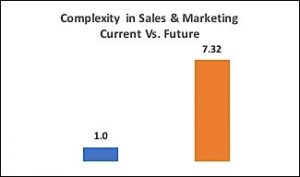Digital Reinvention
CSx – Manage Complexity in Sales & Marketing
August 13, 2018 | Written by: Ramit Gupta
Categorized: Digital Reinvention
Share this post:
Senior executives in Sales and Marketing departments are in unenviable roles. They need to respond to new emerging Competition (both from within and outside the industry) and Consumers’ evolving preference of channels (from physical stores to omnichannel experience to Digital Marketplaces like Amazon or Flipkart). To add to the challenge, new products, pack sizes and features are continuously launched / pulled out.
Layer these external factors with internal co-ordination with multiple departments (like Finance, Logistics and Plants operations), increasing complexity of sales processes and HR issues (Attrition and Training, etc). Phew!
At a client, we estimated that the complexity of Sales & Marketing departments was likely to increase by 7 times in the immediate future driven by 25% to 100% increase in complexity across a few vectors
Increase in complexity index across vectors of Sales & Marketing

Overall increase in Complexity Index in Sales & Marketing

Am sure this is true for your organization as well.
We know that complexity is here to stay and ability to manage complexity at scale across hundreds of employees, thousands of channel partners and millions of customers, is going to be a distinct competitive advantage. Good news is that by leveraging mobility, analytics, cloud and other digital technologies, companies can not only conquer but also thrive in the era of complexity.
Introducing CSx – Cognitive Sales Powered by User Experience.
This involves setting up a Sales & Marketing Center for the entire organization and has six components:
1) Operations Support
In the client I spoke of, we found that 50% of the activities a field salesperson did was administrative in nature. If this time was spent on activities like network expansion, the impact would have been better. Likewise, activities that are rule-based, transactional and repeatable can be consolidated into the central team. This helps in standardization, workflow and SLA based coordination, automation and possible elimination.
In a nutshell, this makes the operations agile with stronger control. These have been practiced for years for back office operations like F&A, Procurement, HR and IT. Companies are beginning to practice this for Sales however, these centers are closer to the market and hence called “mid office”
2) Planning Support
May activities in Planning start with reports (target vs actual, compliance etc) and scenarios. Most of these pre-planning activities are also ruled based and can be initiated by the Mid Office. This ensures leadership spends time on “now what” rather than “what”
3) Cognition
This is the real game changer. Since data is available, different analytical models are built which helps both planning and real-time operations in field. Some examples of analytical models used are
- Planning Activities –Demand Forecast, Price Sensitivity etc
- Operational Activities – Trade Discount, Churn Management, etc
Over time, Cognition will replace Operations Support as the largest component of CSx. Many companies are travelling this path with speed.
4) Co-ordination with Internal Teams
This is done through workflows and are monitored through SLAs. The participants in the workflow is based on Delegation of Authority (DoA)
5) Co-ordination with Customers Field Force
Co-ordination with Customers and Field Force
All types of sales teams (Modern Trade, Traditional, B2B, etc), channel partners and customers can engage with the company through any of the channels they wish to use (Portals, Call Center, Apps, etc). User Experience (Ux) plays a very important role in driving up the adoption in today’s age when there is excess of apps/ portals all around.
6) CxO Dashbards
CSx is not a big bang transformation instead it is built brick by brick over time. Companies like IBM have assets ready to be deployed in 6-8 weeks that can be stretched or scaled depending on client’s needs

Benefits of CSx
Over time, CSx will significantly
- Improve in Sales Efficiency
- Enhance of Customer Lifetime Value
- Increase Channel Affinity
- Enhance Omnichannel Experience for Target Customers
- Improve Sales Velocity and
- Develop Service into a Sales Team
Best of luck in your journey of managing complexity at scale. It can be fun doing so!

Associate Director, Digital Strategy, IBM GBS
Just launched – IBM Security Command Center in India
IBM Security Command Center launch in Bengaluru, India
Insurance Company Brings Predictability into Sales Processes with AI
Generally speaking, sales drives everything else in the business – so, it's a no-brainer that the ability to accurately predict sales is very important for any business. It helps companies better predict and plan for demand throughout the year and enables executives to make wiser business decisions.
Never miss an incident with an application-centric AIOps platform
Applications are bound to face occasional outages and performance issues, making the job of IT Ops all the more critical. Here is where AIOps simplifies the resolution of issues, even proactively, before it leads to a loss in revenue or customers.


